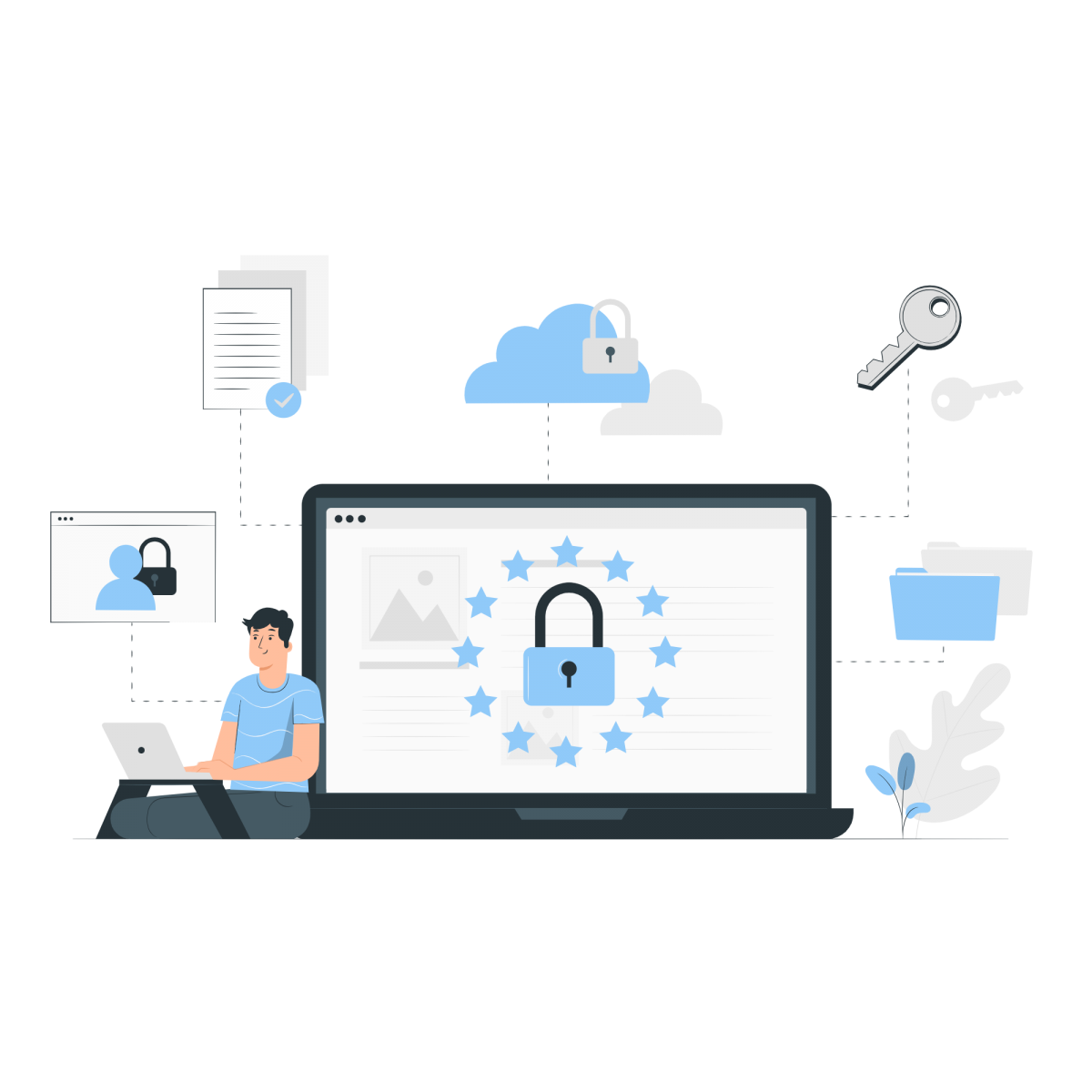[ Bài Viết ] - QUYỀN RIÊNG TƯ VÀ BẢO VỆ DỮ LIỆU
Ngày đăng: 12/04/2024 20:25:24
Tác giả: Thùy Linh
Dịch giả: Thùy Linh
#Cybersecurity
#Personaldata
#Internetprivacy
* Bài viết dành cho các bạn học viên Octo. tham khảo
----------------------------------
QUYỀN RIÊNG TƯ VÀ BẢO VỆ DỮ LIỆU
< English below >
Trong thời đại số hóa ngày nay, quyền riêng tư và bảo vệ dữ liệu cá nhân đóng vai trò quan trọng trong việc đảm bảo an toàn và tin cậy cho người dùng. Cùng với sự phát triển của công nghệ thông tin, các quy định bảo vệ dữ liệu cá nhân đã được đưa ra để giúp người dùng kiểm soát thông tin cá nhân của mình và đảm bảo rằng dữ liệu được xử lý và lưu trữ một cách an toàn. Trong bài viết này, chúng ta sẽ phân tích chi tiết về các quy định bảo vệ dữ liệu cá nhân, bao gồm chính sách bảo mật dữ liệu, phân loại dữ liệu và các biện pháp bảo mật dữ liệu.
1. Chính sách bảo mật dữ liệu
Chính sách bảo mật dữ liệu là tài liệu quy định các quy tắc và quyền riêng tư liên quan đến việc thu thập, sử dụng và bảo vệ dữ liệu cá nhân. Chính sách này phải tuân thủ các quy định pháp luật và tiêu chuẩn an ninh liên quan, và cung cấp hướng dẫn cho việc xử lý dữ liệu cá nhân một cách đúng đắn và minh bạch. Chính sách bảo mật dữ liệu thường bao gồm các mục tiêu, phạm vi áp dụng, các quyền và nghĩa vụ của người dùng và tổ chức, quy trình thu thập và xử lý dữ liệu, và các biện pháp bảo mật.
.png)
2. Phân loại dữ liệu
Việc phân loại dữ liệu là quá trình xác định và đánh giá loại dữ liệu cá nhân mà tổ chức thu thập và xử lý. Phân loại dữ liệu giúp định rõ mức độ nhạy cảm của thông tin và xác định các biện pháp bảo mật phù hợp. Thông thường, dữ liệu được phân loại thành các loại như thông tin cá nhân cơ bản (tên, địa chỉ, số điện thoại), thông tin tài chính, thông tin y tế, thông tin địa lý và các loại dữ liệu đặc biệt khác. Việc phân loại dữ liệu cần tuân thủ các quy định pháp luật liên quan đến việc bảo vệ dữ liệu cá nhân.
3. Biện pháp bảo mật dữ liệu
Để đảm bảo an toàn cho dữ liệu cá nhân, các tổ chức cần triển khai các biện pháp bảo mật phù hợp. Dưới đây là một số biện pháp bảo mật dữ liệu quan trọng:
- Mã hóa dữ liệu: Mã hóa dữ liệu là quá trình chuyển đổi thông tin thành dạng không đọc được cho những người không có quyền truy cập. Việc áp dụng mã hóa dữ liệu giúp đảm bảo rằng dữ liệu chỉ có thể được đọc bởi những người được ủy quyền.
- Quản lý quyền truy cập: Các tổ chức cần thiết lập chính sách quản lý quyền truy cập để kiểm soát quyền truy cập vào dữ liệu cá nhân. Điều này đảm bảo rằng chỉ những người được ủy quyền mới có thể truy cập và xử lý dữ liệu.
- Đào tạo nhân viên: Việc đào tạo nhân viên về quyền riêng tư và bảo vệ dữ liệu là rất quan trọng. Nhân viên cần được hướng dẫn về các quy định bảo vệ dữ liệu, phương pháp xử lý dữ liệu một cách an toàn và các biện pháp bảo mật cần thiết để tránh rủi ro.
- Kiểm tra và đánh giá: Các tổ chức nên thực hiện kiểm tra và đánh giá định kỳ để đảm bảo rằng các biện pháp bảo mật dữ liệu đang hoạt động hiệu quả. Điều này bao gồm việc kiểm tra hệ thống bảo mật, xác minh tuân thủ chính sách bảo mật và xử lý các lỗ hổng bảo mật nếu có.
- Bảo vệ vật lý: Đảm bảo rằng các trang thiết bị lưu trữ dữ liệu được bảo vệ khỏi các nguy cơ như truy cập trái phép, mất mát và hỏng hóc. Điều này bao gồm cả bảo vệ trước các mối đe dọa từ người sử dụng nội bộ và các mối đe dọa từ bên ngoài như trộm cắp, hỏa hoạn hoặc thiên tai.

Một số biện pháp bảo vệ vật lý dữ liệu bao gồm:
-
Cơ sở hạ tầng vật lý an toàn: Đảm bảo rằng các trang thiết bị lưu trữ dữ liệu được đặt trong môi trường an toàn như phòng máy chủ, trung tâm dữ liệu hoặc các cơ sở lưu trữ đám mây.
-
Hệ thống kiểm soát truy cập: Sử dụng các biện pháp đảm bảo chỉ những người được ủy quyền mới có thể truy cập vào các vị trí lưu trữ dữ liệu như sử dụng hệ thống khóa, thẻ thông minh, mã PIN hoặc công nghệ nhận dạng sinh trắc học.
-
Bảo vệ các thiết bị lưu trữ: Đảm bảo rằng các thiết bị lưu trữ dữ liệu như máy chủ, ổ cứng hoặc băng đĩa được bảo vệ khỏi mất mát, hỏng hóc hoặc truy cập trái phép. Tổ chức có thể sử dụng các giải pháp như hệ thống sao lưu dữ liệu, két sắt hoặc hệ thống chống cháy.
-
Giám sát và kiểm soát: Theo dõi và giám sát các trang thiết bị lưu trữ dữ liệu để phát hiện sớm các vấn đề bảo mật vật lý có thể xảy ra. Có thể sử dụng các công cụ giám sát, hệ thống cảnh báo hoặc các biện pháp kiểm soát khác để đảm bảo tính toàn vẹn và sẵn sàng của các thiết bị lưu trữ.
- Bảo vệ mạng: Đảm bảo an toàn cho mạng và hệ thống là một phần quan trọng của bảo mật dữ liệu. Các biện pháp bao gồm cài đặt firewall, phần mềm chống virus, cập nhật hệ điều hành và ứng dụng thường xuyên, và quản lý các quyền truy cập mạng.
- Xóa dữ liệu: Khi dữ liệu cá nhân không còn cần thiết, các tổ chức cần xóa hoặc tiêu hủy dữ liệu một cách an toàn. Điều này đảm bảo rằng dữ liệu không thể khôi phục và không bị lạm dụng sau khi không còn sử dụng.

Tóm lại, việc tuân thủ các quy định bảo vệ dữ liệu cá nhân không chỉ đảm bảo quyền riêng tư của người dùng mà còn tạo ra một môi trường an toàn cho người dùng. Chính sách bảo mật dữ liệu, phân loại dữ liệu và các biện pháp bảo mật dữ liệu là những yếu tố quan trọng trong việc thực hiện quyền riêng tư và bảo vệ dữ liệu cá nhân. Vì vậy, các tổ chức cần thực hiện và duy trì các biện pháp bảo mật phù hợp để đảm bảo an toàn cho dữ liệu và xây dựng niềm tin cho người dùng.
PRIVACY AND DATA PROTECTION
Privacy and data protection are crucial in today's digital age to ensure user safety and trust. With the development of information technology, regulations have been implemented to help users control their personal information and ensure that data is handled and stored securely. In this article, we will analyze in detail the personal data protection regulations, including data privacy policies, data classifications, and data privacy measures.
1. Data Privacy Policy
A data privacy policy is a document that regulates the rules and privacy regarding the collection, use, and protection of personal data. This policy must comply with relevant laws and security standards and guide the proper and transparent processing of personal data. A data privacy policy generally covers the objectives, scope of application, rights and obligations of users and organizations, data collection and processing procedures, and security measures.
.png)
2. Data classification
Data classification is the process of identifying and evaluating the type of personal data an organization collects and processes. Data classification helps define the sensitivity of information and determine appropriate security measures. Typically, data is classified such as basic personal information (name, address, phone number), financial information, medical information, geographic information, and other special types of data. The classification of data should comply with the legal provisions related to the protection of personal data.
3. Data security measures
To ensure the safety of personal data, organizations need to implement appropriate security measures. Here are some important data security measures:
- Data encryption: Data encryption is the process of converting information into an unreadable form for people who do not have access. The application of data encryption helps ensure that data can only be read by authorized persons.
- Access management: Organizations need to establish access management policies to control access to personal data. This ensures that only authorized persons can access and process the data.
- Employee training: It is very important to train employees on privacy and data protection. Employees should be instructed on data protection regulations, methods for handling data securely, and necessary security measures to avoid risks.
- Audits and evaluations: Organizations should perform periodic audits and audits to ensure that data security measures are working effectively. This includes auditing security systems, verifying security policy compliance, and addressing any security vulnerabilities.
- Physical protection: Ensures that data storage facilities are protected from hazards such as unauthorized access, loss, and failure. This includes both protection against insider threats and external threats such as theft, fire, or natural disasters.

Some of the physical data safeguards include:
-
Secure physical infrastructure: Ensure that data storage facilities are located in a secure environment such as server rooms, data centers, or cloud storage facilities.
-
Access control systems: Use measures to ensure that only authorized persons can access data storage locations such as using locking systems, smart cards, PINs, or biometric identification technology.
-
Physical protection of storage devices: Ensure that data storage devices such as servers, hard drives, or tapes are protected from loss, damage, or unauthorized access. Organizations can use data backup systems, safes, or fire protection systems.
-
Monitoring and control: Monitor and monitor data storage facilities for early detection of possible physical security issues. Monitoring tools, warning systems, or other controls can be used to ensure the integrity and availability of storage devices.
- Network protection: Ensuring network and system safety is an important part of data security. Measures include installing firewalls, and antivirus software, updating operating systems and applications regularly, and managing network access.
- Data deletion: When personal data is no longer needed, organizations need to securely delete or destroy it. This ensures that the data is unrecoverable and not misused after it is no longer in use.

To sum up, adhering to personal data protection regulations not only guarantees user privacy but also fosters a secure environment for users. Data security policies, data classifications, and data security measures are vital elements in safeguarding personal data and ensuring privacy. Therefore, companies should establish and uphold appropriate security measures to ensure data safety and to gain user trust.
______________________________________________________
Anh ngữ Octo.
Thông tin liên hệ:
-Fanpage: https://www.facebook.com/hp.octo
-Email: services@octo.vn
-Hotline: 0282 2002244
-Địa chỉ: 45 đường D2A, Khu Manhattan - Vinhomes Grand Park, Tp. Thủ Đức
